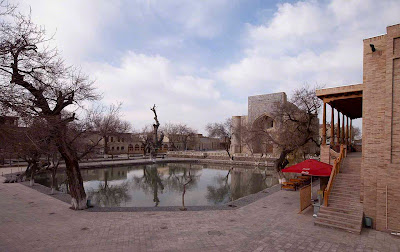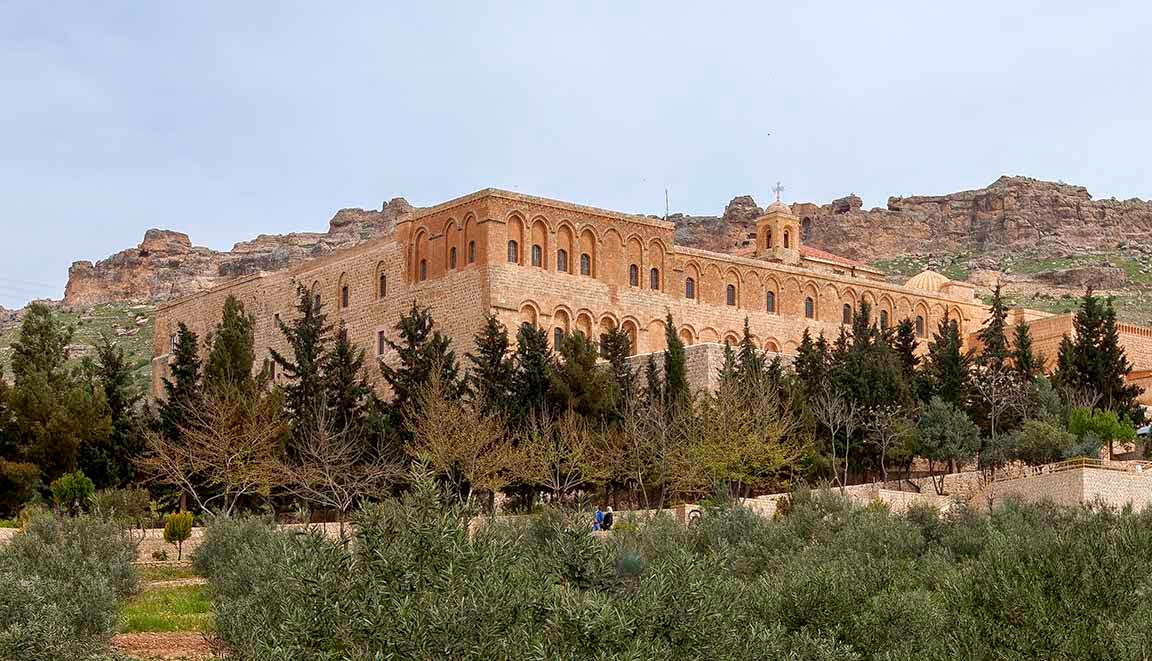Uzbekistan | Bukhara | Lyab-i-Haus
Arguably the social center of modern Bukhara is the Lyab-i-Haus Complex, named after the haus, or reservoir in its middle. In summer the reservoir is lined with tables served by nearby restaurants and the square itself is thronged with local idlers of all persuasions, sight-seers, tourists, and Turkish adventuresses. In late winter the square around the reservoir is pretty much deserted.
Lyab-i-Haus Complex, looking west (Click on photos for Enlargements)
On the north side of the square is a two-story restaurant and to the right, across a street, is the Kukeldash Madrassa. The south side of the square is lined with stores and Hotels.
The Kukeldash Madrassa, which now faces the Lyabi-Haus Complex, pre-dates the complex itself. It was built in 1568-1589 at the time of Shaibanid ruler Abdullah Khan, during whose reign Trade Dome #1, Trade Dome #2, the Abdullah Khan Tim, and probably Trade Dome #3 were also constructed. Commissioned by Abdullah Khan’s general and foster brother Qul Baba Kukeldash (kukeldash = foster brother), the madrassa, measuring 262 by196 feet and containing 160 cells, is the largest in Bukhara and one of the largest in Inner Asia.
Kukeldash Madrassa (1568 - 1569)
The Janids, or Ashtarkhanids (1599–1681) seized power after the fall of the Shaibanids. The dynasty was founded by Jani Yar Muhammad, who fled from Astrakhan, north of the Caspian Sea, after the Russian invasion of the area, He married a sister of Abdullah Khan’s and their son Baqi Mohammad took control of Bukhara and the surrounding area in 1599. He died in 1605. After a short reign by Wali Muhammad Khan (1605-1611), Imam Quli Bahadur Khan (r.1611-1641) came to power. During his reign the Uzbek state and Bukhara in particular experienced a resurgence, vying with Ottoman Turkey, Safavid Persia, and the Moghuls of India for power in the Islamic geo-sphere.
The construction of the Lyab-i-Haus complex, including the reservoir, the Nadir Divan Beg Madrassa, and the Nadir Divan Beg Khanaka (Sufi monastery), were built between the years 1620 and 1623, during the reign of Imam Quli Bahadur Khan. They were commissioned by Nadir Divan Beg Tughai, a high official in the Uzbek court and the uncle (tughai) of Imam Quli Bahadur Khan. The madrassa was originally intended to be a caravanserai, as can be seen by its design, but later, at an uncertain date, was converted into a madrassa.
Nadir Divan-Beg Khanaka (c.1620)
Another view of the Nadir Divan-Beg Khanaka
Side view of the Nadir Divan-Beg Khanaka. The building is now undergoing restoration.Front of the Nadir Divan-Beg Khanaka
One reason I went to Bukhara when I did was to witness the spectacular conjunction of Venus and Jupiter in the western sky around the middle of March. I really wanted to see these two planets pop out in close proximity over Bukhara as night fell. I was not disappointed! For five nights in a row I went out to witness this magnificent spectacle. The same sight appeared over Kashgar in the year 1215.
Venus (the bigger of the two) and Jupiter just visible above Divan Beg Khanaka on the night of the 13th. (Click on photos for Enlargements)
To the east of the reservoir is the Nadir Divan Beg Madrassa, originally constructed as a caravanserai but late converted into a madrassa.
Nadir Divan Beg Madrassa
Front of Nadir Divan Beg Madrassa
Front of Nadir Divan Beg Madrassa
Interior of the madrassa
Detail of the interior of the madrassa
In front of the madrassa is a statue of the famous trickster Khodja Nasreddin. He is the The Subject Of Innumerable Books and Stories. One of the best is The Tale of Hodja Nasreddin: Disturber of the Peace, which takes place in Bukhara. The donkey plays a key role in the story also.
Khodja Nasreddin



















